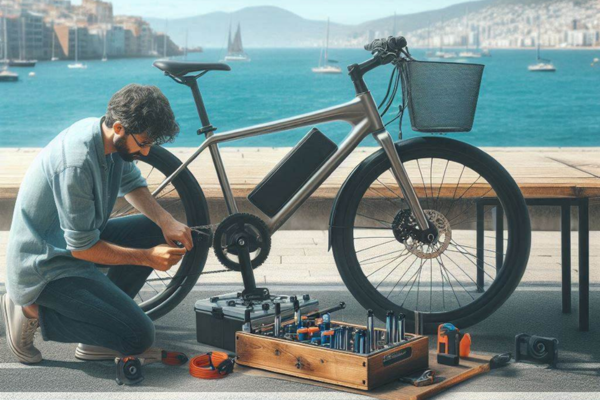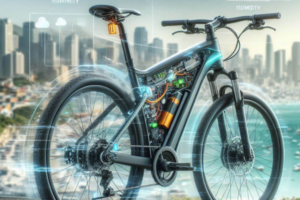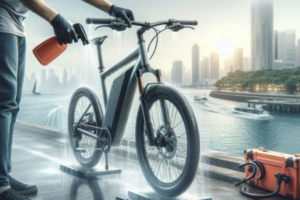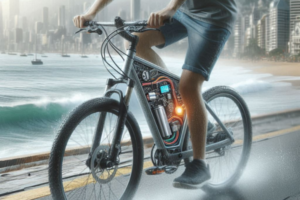🌧️ Importance of Energy Efficiency in Electric Bicycles in Coastal Cities
In coastal cities, electric bicycles have become a sustainable and efficient transportation option. However, the high humidity and adverse weather conditions typical of these regions can significantly affect the performance of electric bicycles. Maintaining good energy efficiency not only helps extend the lifespan of components but also optimizes energy consumption, which is crucial for users who rely on their bicycles daily.
💨 Specific Challenges of Humid Climate and Its Impact on Electric Bicycle Performance
The coastal environment, characterized by high humidity and salinity levels, poses unique challenges for the maintenance of electric bicycles. Humidity accelerates the corrosion of electrical and mechanical components, while constant exposure to salt can damage metal parts and compromise the energy efficiency of the system. Additionally, batteries often wear out more quickly in these conditions, reducing their storage capacity and lifespan.
⚡ Impact of Humid Climate on Energy Performance
The humid climate has a significant effect on the energy performance of electric bicycles, and understanding these impacts is essential for any cyclist living in coastal cities.
💨 Increased Aerodynamic Drag
The humidity in the air can increase rolling resistance. When the air contains more water vapor, it becomes denser, which in turn increases the aerodynamic resistance that the bicycle must overcome. This means the cyclist has to exert more effort to maintain the same speed, resulting in higher energy consumption and lower overall efficiency.
🔋 Corrosion of Electrical and Mechanical Components
Constant exposure to humidity can cause corrosion in the electrical and mechanical components of the bicycle. Metal parts, such as the frame, chains, and gears, are particularly vulnerable. Corrosion not only weakens these parts but can also affect their functionality, leading to premature wear and a decrease in bicycle efficiency.
🔋 Impact on the Battery
The batteries of electric bicycles are also sensitive to humid conditions. High humidity can affect the internal chemistry of the battery, reducing its capacity and shortening its lifespan. Moreover, batteries exposed to humidity may experience issues such as short circuits or performance degradation, resulting in reduced range and the need for more frequent recharges.
🛠️ Protection Strategies for Components
Protecting the components of electric bicycles in humid climates is essential to ensure their performance and extend their lifespan. Here are some effective strategies:
🧴 Waterproof Coatings and Sealants
One of the best ways to protect electrical and mechanical components is to apply waterproof coatings and sealants. These products create a barrier that prevents moisture and water from entering, thus protecting the electrical systems from corrosion and damage.
⚙️ Use of Water-Resistant Parts
When choosing materials for your bicycle, opt for parts designed to withstand moisture. This includes components like sealed bearings, water-resistant coated cables, and moisture-proof connectors. These parts not only handle humid conditions better but also reduce the need for frequent maintenance.
🔋 Maintenance of Electrical Connections
Electrical connections are especially susceptible to humidity. Regular maintenance is crucial to prevent short circuits and corrosion. Make sure to clean the connections and apply an appropriate sealant that protects them from moisture.
💨 Optimization of Riding in Humid Climates
To maximize the energy efficiency of electric bicycles in humid climates, it is essential to adjust both mechanical components and riding style. Here are some key strategies:
🧑🔧 Adjustments to Riding Style
Adopting a more efficient riding style can significantly reduce energy consumption. This includes maintaining a steady speed and avoiding sudden accelerations. Using electrical assistance appropriately according to the terrain can also help conserve battery energy.
🛞 Optimization of Tire Pressure
Tire pressure plays a crucial role in energy efficiency, especially on wet surfaces. Make sure to maintain the appropriate pressure according to the manufacturer’s recommendations. Slightly under-inflated tires increase rolling resistance, resulting in greater effort and higher energy consumption.
🗺️ Selection of Efficient Routes
Choosing the right routes can make a big difference in energy performance. Opt for well-paved paths and avoid routes with a lot of mud or uneven surfaces, as they require more effort. Consider routes that offer gentle slopes and fewer stops to maintain a steady and efficient speed.
🔋 Specific Care for the Battery
The battery is one of the most critical components of an electric bicycle, and its performance can be significantly affected in humid climates. Here are some strategies for properly caring for the battery:
🛡️ Protection Against Moisture
To ensure that the battery operates optimally, it is essential to protect it from moisture. Use waterproof covers that fit snugly around the battery compartment. Apply a sealant or coating on the terminals and electrical connections to prevent corrosion.
🏠 Proper Storage
When not using the bicycle, make sure to store it in a dry and ventilated place. If you live near the coast, where humidity can be high, store the bicycle in a garage or enclosed space that offers protection. If possible, remove the battery and store it in a dry location.
🔋 Regular Maintenance
To prolong the battery life in coastal climates, it is crucial to perform regular maintenance. Clean the battery terminals and connections with a dry, soft cloth to remove any moisture or dirt buildup.
⚙️ Technological Innovations for Energy Efficiency
In the world of electric bicycles, technology is rapidly advancing, offering innovative solutions that enhance energy efficiency, especially in humid climates. Below are some of these innovations:
📊 Energy Monitoring Systems
Energy monitoring systems are key technological tools that allow cyclists to monitor their bicycle’s performance in real-time. These systems can provide data on energy consumption, battery charge, and overall performance, helping users optimize their riding style.
🚲 Specialized Tires for Humid Climates
Tires are a crucial component in the energy efficiency of electric bicycles. In humid climates, it is vital to have tires specifically designed for these conditions. These tires typically feature an optimized tread design that improves traction on wet surfaces, reducing the risk of slipping.
💡 Technological Upgrades
Recent innovations in the field of electric bicycles have led to the creation of components and systems that address the challenges of humid climates. Some models incorporate driver assistance systems that automatically adjust power based on terrain and weather conditions, ensuring efficient energy use.
🔋 Conclusion: Best Practices for Maintaining Energy Efficiency in Humid Climates
We’ve explored several practical strategies to maintain your electric bicycle’s energy efficiency in humid climates. From proper component protection and optimized riding techniques to specific battery care, these maintenance strategies will ensure your bicycle performs at its best despite the challenges of a coastal environment.
What maintenance strategies have you found most effective for your electric bicycle in humid climates? Share your tips in the comments below!



